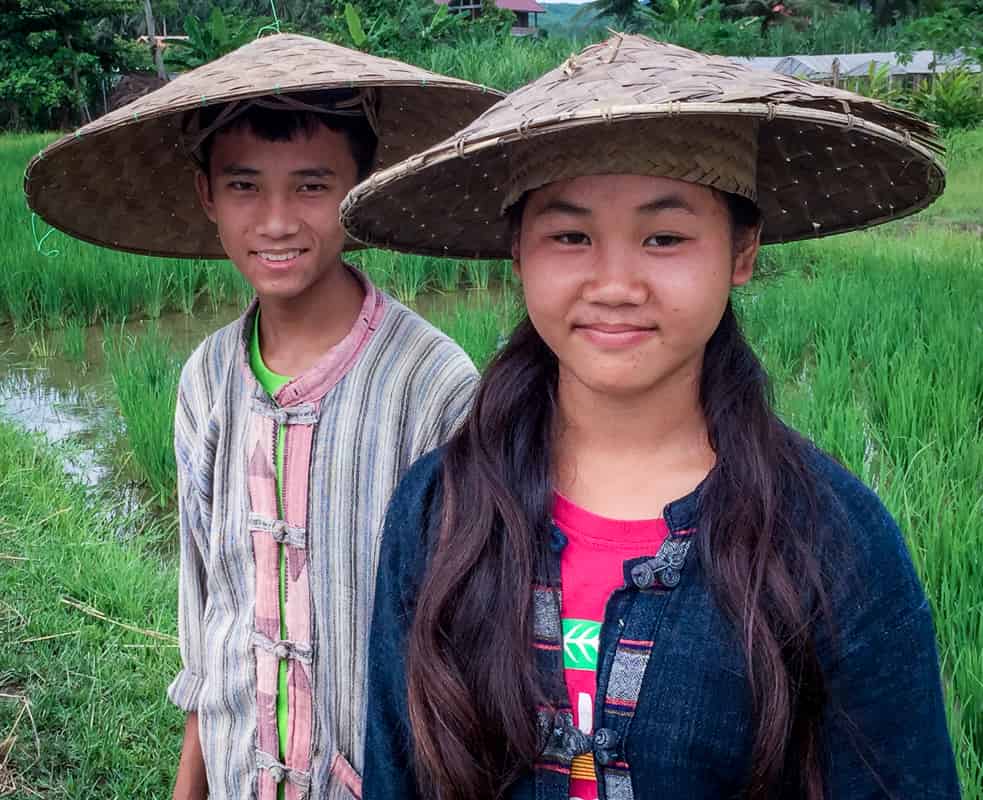There’s more to rice than boiling a cup of basmati in the microwave, as Justine Tyerman discovers on a trip to Laos.
The last thing I expected at the Living Land Farm near Luang Prabang in Laos was to meet a comedian.
Our guide Khamla, a born entertainer, had us in fits of laughter, as he demonstrated the 13 steps of rice production assisted by a couple of delightful Lao youngsters.

I was astounded to learn that there are thousands of different types of rice and 500 types of sticky rice, the variety grown in Laos and eaten as a staple food, three times a day.
The process of growing rice starts with selecting the best grains by soaking them in salted water. The good grains sink and the bad grains float. Nothing is wasted. The rejects are fed to the chooks.
The seeds are then planted in a nursery to grow into seedlings. The paddy fields are ploughed, the seedlings transplanted, watered, weeded, harvested, threshed, husked, sorted and winnowed before being soaked overnight and cooked.
Sticky rice is steamed, never boiled. We watched the rice being cooked in a bamboo basket on top of a pot of simmering water over an open fire.
Our keen Kiwi crew donned coolie hats and had a go at everything from preparing the paddy field with help of Rudolf, the friendly water buffalo, to threshing the rice after harvesting. The whole process is done the traditional way without the use of mechanisation.
We also ground rice into flour for noodles and pressed sugar cane to extract the sweet juice using an ancient wooden press.
Khamla turned some of the time-consuming, labour-intensive steps like threshing into a dance, and the back-breaking task of carting hefty baskets of rice to storage into a comedy skit. It made the demonstration not just informative but also highly entertaining.
The Kiwis enthusiastically took part in the 14th and most popular part of the process, eating the finished product. We sat on the shady balcony of the Terrace Restaurant overlooking the green paddy fields and sampled a range of delicious rice-based snacks and rice wine prepared by the lovely local Lao ladies.
Khamla also showed us around the extensive organic gardens and shade houses, and we watched a couple of men making intricate animal shapes out of a bamboo to give to visitors.
I talked to Living Land Farm assistant manager Sia Lee whose passion for his work radiated from his beaming face. He said the farm was founded in 2005 as an entirely organic, community enterprise run by a local team for the benefit of the Lao people.
“We grow organic vegetables, salad greens, herbs and rice and supply leading restaurants and hotels in Luang Prabang. We employ workers who have learning difficulties or physical disabilities who are unable to find work. Our project supports children from poor families with their education and medical needs. We offer free English language classes to children from local villages and act as a training centre for agriculture students,” he said.
“By introducing organic and land-friendly methods like organic composting, crop-rotation, fallow periods, green manure and the use of natural, locally-available means to encourage growth and control invasive insects and diseases, we ensure the continuing fertile use of land.”
I liked Sia’s philosophy… and his loving care of the land.
Factbox
Justine Tyerman travelled with Innovative Travel, a Christchurch-based boutique tour operator with 27 years’ experience offering travellers the opportunity to explore historically and culturally unique destinations worldwide that provide a challenge but with the security of a peace-of-mind 24/7 wrap-around service.
Travel Companions’ Club creating new horizons for social travellers: www.travelcompanions.club
Getting there:
Singapore Airlines flies from Auckland to Singapore daily, from Wellington four times weekly, and from Christchurch daily. Singapore Airlines has a code-share agreement with Swiss International Airlines (SWISS).
SilkAir flies from Singapore to Vientiane and Luang Prabang three times weekly.
Lao Airlines flies from Vientiane to Xieng Khuang.
Accommodation:
Parasol Blanc, Luang Prabang.